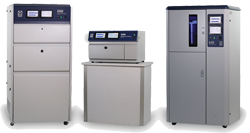【Q-LAB】
氙灯老化试验箱_盐雾试验箱_紫外光老化试验箱
咨询热线
18566398802ASTM G156-2017
ASTM G156 用作监控曝晒测试环境的持续性的老化参考材料的选择和鉴别的标准方法(风化标准物质的选择与表征的标准实施规程)
ASTM G156-2017发行信息
中文名 风化标准物质的选择与表征的标准实施规程
英文名Standard Practice for Selecting and Characterizing Weathering Reference Materials
标准号ASTM G156-2017
发布日期2017
实施日期
废止日期无
中国标准分类号A21
国际标准分类号19.040
发布单位US-ASTM
ASTM G156-2017适用范围
Weathering reference materials are used in laboratory accelerated exposure tests to verify consistency among tests run at different times and in different laboratories, using the same exposure conditions. Specifications defining consistency of exposure conditions are based on the property change of a reference material after a defined period of time. Some weathering reference materials are used to define periods of exposure. Specifications calling for use of these materials require the material to be exposed until a defined change in the weathering reference material is achieved. Specifications are usually based on results for a single lot of the weathering reference material. When a new lot of the reference material is introduced, round-robin studies are necessary to compare the new and old lots and to establish appropriate limits for expected performance of the new lot.
Note 28212;An example of the use of a clear polystyrene reference standard for this purpose is given in SAE J1885 and SAE J1960.
Note 38212;Some weathering reference materials (for example blue wools) are also used to define periods of exposure. Although not specifically covered by this standard, the procedures described for characterizing a reference material used to monitor consistency of exposures are also generally applicable to characterizing reference materials used to define periods of exposure.
It is important to test the consistency of exposure in the laboratory accelerated device with a weathering reference material that responds to the test conditions similar to the way the test materials respond. Therefore, the weathering reference material should be sensitive to the spectral region of the light source mainly responsible for producing degradation in the test materials to provide the most meaningful evaluation of exposure test consistency. The weathering reference material should also provide information on consistency of temperature and humidity conditions if the latter are important factors in degradation of the test materials.
Note 48212;Material homogeneity can also be an important factor in selection of a weathering reference material, particularly if weathering is initiated by the radiation absorbed by impurities as is the case in aliphatic type polymers exposed to radiation longer than 300 nm.
The measurement of the characteristic property of a weathering reference material can be subject to error depending on the instrument and the procedure used to measure the property. It is important to develop measurement procedures that are clear and which minimize chances for operator misinterpretation. It is also important to determine the level of variability caused by measurement of the characteristic property.
When a reference material is used to monitor or specify the consistency of an exposure test, it is important that any specification limits defined by changes in the reference material be based on a sound statistical analysis of results from a properly designed round-robin experiment. This practice provides a procedure which can be followed to set up the round-robin, analyze results, and establish reasonable limits of change in the characteristic property of the reference material that can be used in specifications.
The results obtained according to this practice are valid only for the exposure cycle used for the round-robin and cannot be applied to the same weathering reference material used in a different exposure cycle.
The change in characteristic property of a reference material may be affected by the placement of the reference material in the exposure device. This is often due to variations in light intensity and temperature within the allowed exposure area. Random placement of replicate specim.........
1.1 This standard describes the criteria to be used for selection of a weathering reference material (WRM) and procedures to be used for determining within lab and between lab tolerances of changes in measured properties of weathering reference materials. This standard also describes a procedure for comparing different lots of the same type of a weathering reference material.
NOTE 1:Examples of laboratory accelerated tests in which a weathering reference material could be used to monitor consistency are exposure tests such as those described in Practices G152, G153, G154, and G155and other standards in which tests conducted according to these standards are referenced. Examples of outdoor exposures where a weathering reference material could be used to monitor consistency are those conducted according to Practices G7, G24, or G90. A reference material can also be used to monitor consistency of exposure or conditioning test that do not involve exposure to light.
1.2 Weathering reference materials are most often used to (1) monitor consistency (that is, repeatability, reproducibility, or both) of exposure tests, (2) to determine the time or radiant exposure at which test materials are evaluated, (3) as a reference material for comparing to test materials exposed at the same time. Weathering reference materials cannot be used to classify or characterize the relative severity of any exposure test because of the large variability in material responses to the effects of light, heat, and water.
1.3 This practice does not cover control materials which, by definition are selected to be of similar composition and construction to the test materials, and are exposed at the same time as test materials.
1.4 This practice provides an outline of experiments required to determine how the measured properties of the reference material change as a function of exposure to specified test conditions. It includes establishment of reproducible measurement procedures, determination of the critical spectral region in the light source causing the changes, and effects of other critical exposure stresses such as temperature and moisture.
1.1本标准描述了用于选择风化标准物质(WRM)的标准以及用于确定实验室内和实验室间风化标准物质测量特性变化公差的程序。本标准还描述了比较同一类型风化标准物质不同批次的程序。
注1:可使用风化标准物质监测一致性的实验室加速试验示例包括暴露试验,如规程G152、G153、G154和G155中所述的试验,以及根据这些标准进行试验的其他标准。可使用风化标准物质监测一致性的室外暴露示例是根据规程G7、G24或G90进行的暴露。参考材料也可用于监测不涉及光照的暴露或调节试验的一致性。
1.2风化标准物质最常用于(1)监测暴露试验的一致性(即重复性、再现性或两者兼有),(2)确定评估试验材料的时间或辐射暴露,(3)作为与同时暴露的试验材料进行比较的标准物质。由于材料对光、热和水影响的响应具有很大的可变性,因此不能使用风化参考材料对任何暴露试验的相对严重性进行分类或表征。
1.3本规程不包括控制材料,根据定义,控制材料的成分和结构与试验材料相似,并与试验材料同时暴露。
1.4本规程提供了确定标准物质的测量特性如何随暴露于规定试验条件而变化所需的试验大纲。它包括建立可再现的测量程序,确定引起变化的光源中的临界光谱区域,以及温度和湿度等其他临界暴露应力的影响。